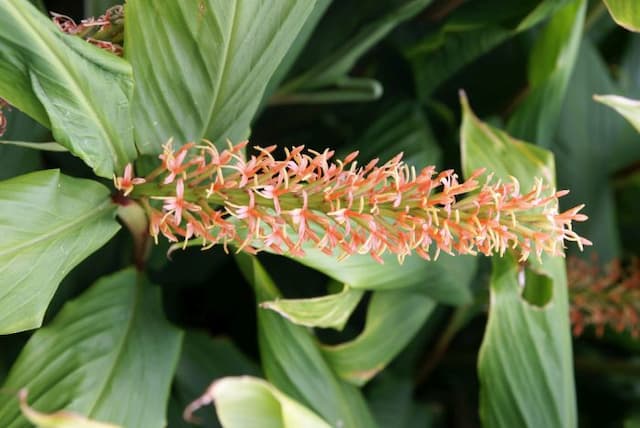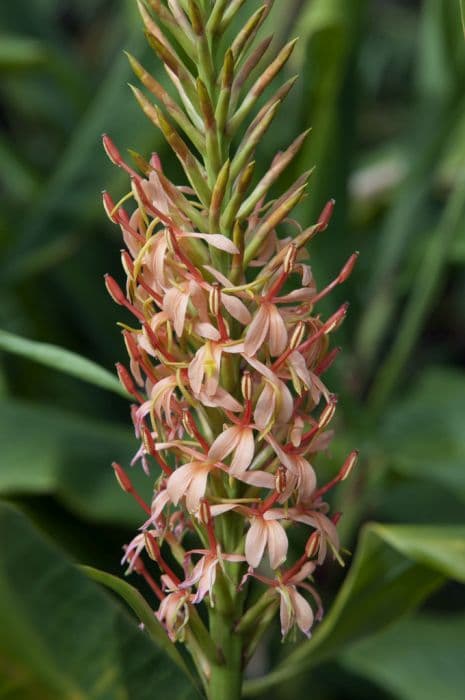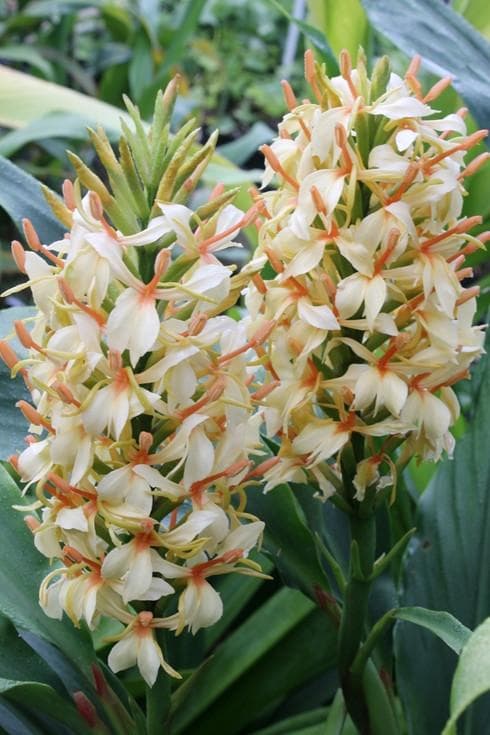Summerhays' Roscoea Roscoea auriculata

ABOUT
Roscoea auriculata, commonly known as Summer Common Ginger, is a perennial herb noted for its distinctive features. Its leaves are lance-shaped, with a deep green hue, appearing orderly on the stem. The plant bears exotic-looking flowers that are a prominent attraction. These blooms possess a unique charm with their orchid-like appearance, coming in a range of colors from purple to lavender, sometimes showcasing a creamy white or pale yellow throat. The flowers are tubular at the base, widening at the mouth into large, striking petals. The Summer Common Ginger attracts attention with its strong, upright stems, which hold the inflorescence aloft. These stems rise from a clump of deeply veined foliage that forms an elegant mound with a lush and dense appearance. Adding to its exotic flair, the Summer Common Ginger has a rosette of bracts at the base of each flower, providing a beautiful contrast against the blooms. As part of its life cycle, this plant emerges from a rhizome, and with the onset of warmer weather, it becomes more vigorous and colorful. The overall appearance of Summer Common Ginger is one of tropical charm, enhancing gardens with its vibrant flowers and structured foliage, creating a focal point wherever it's placed. Despite its common name, it is not related to the usual culinary ginger and is valued primarily for its ornamental appeal. Its beauty tends to peak during the summer months when the plant is in full bloom.
About this plant
 Names
NamesFamily
Zingiberaceae
Synonyms
Ear-leaved Ginger, Chinese Ginger
Common names
Roscoea auriculata.
 Toxicity
ToxicityTo humans
Roscoea auriculata, commonly known as Chinese ginger, does not have a well-documented history of toxicity to humans. There is no specific information about this plant being poisonous to humans, and it is not commonly listed among toxic or hazardous plants. Therefore, while general caution should be exercised when handling or ingesting unknown plants, there do not appear to be any known toxic effects from Chinese ginger to humans reported in widely acknowledged sources. However, individual allergic reactions or sensitivity to the plant can occur.
To pets
Chinese ginger is not known to be toxic to pets. There is no specific information indicating that Roscoea auriculata is poisonous to animals. It is not listed among commonly known toxic plants to cats, dogs, or other domestic pets. Therefore, there are no specific symptoms of poisoning associated with this plant reported in widely acknowledged sources. However, as with humans, individual pets might have allergies or sensitivities to the plant, and it is always good practice to prevent pets from ingesting plants not meant for consumption.
 Characteristics
CharacteristicsLife cycle
Perennials
Foliage type
Deciduous
Color of leaves
Green
Flower color
Purple
Height
1-2 feet (0.3-0.6 meters)
Spread
0.5-1 feet (0.15-0.3 meters)
Plant type
Herb
Hardiness zones
6
Native area
Himalayas
Benefits
 General Benefits
General Benefits- Ornamental value: Roscoea auriculata, commonly known as Himalayan ginger, is prized for its attractive purple or lavender flowers, which can enhance the aesthetic of gardens and landscapes.
- Durability: This plant is known for being hardy and can tolerate a range of conditions once established, making it suitable for various garden settings.
- Attracts pollinators: The vibrant flowers of Himalayan ginger are known to attract bees and butterflies, which are beneficial for pollination in the garden.
- Low maintenance: Himalayan ginger generally requires minimal care once established, needing only occasional watering and the removal of spent flowers.
- Shade tolerance: Able to grow in partial shade, Himalayan ginger is an excellent option for underplanting in woodland gardens or other shaded areas.
- Culinary use: Although not a primary benefit, Roscoea auriculata is related to the ginger family, and some species can be used in cooking, typically in Himalayan cuisine.
- Seasonal interest: This perennial adds seasonal interest with its late spring to summer blooming period, offering a burst of color when many other plants are not in flower.
- Compact size: Himalayan ginger tends to have a compact growth habit, which makes it suitable for small gardens or container planting.
- Edge planting: Due to its moderate height, it can be effectively used for border edges, pathways, or as part of a structured garden design.
 Medical Properties
Medical PropertiesThis plant is not used for medical purposes.
 Air-purifying Qualities
Air-purifying QualitiesThis plant is not specifically known for air purifying qualities.
 Other Uses
Other Uses- Roscoea auriculata, commonly known as 'Himalayan ginger,' can be used as a natural dye for fabrics, providing hues from its roots and flowers.
- The fibrous nature of its roots allows it to be used in crafting ropes and twines in small-scale traditional practices.
- The distinctive flowers of Himalayan ginger can be used in decorative floral arrangements, adding exotic appeal to bouquets.
- Leaves of the plant can be used as mulch in gardens to help retain soil moisture and suppress weeds.
- Insects, particularly bees, are attracted to the flowers, making the plant a useful addition to gardens to promote pollination.
- The plant's ability to tolerate shade makes it ideal for ground cover in woodland gardens, providing greenery in dimly lit areas.
- When dried, the leaves of Himalayan ginger can be used to create a natural potpourri with a subtle, pleasant fragrance.
- Its robust rhizomes can help in soil stabilization on slopes, preventing soil erosion in hilly gardening landscapes.
- Pressed and dried flowers of the plant could be used in the art of botanical paper-making or for creating decorative bookmarks and cards.
- Edible parts of Himalayan ginger can be incorporated into culinary dishes as an exotic garnish, adding a unique flair to presentations.
Interesting Facts
 Feng Shui
Feng ShuiRoscoea auriculata is not used in Feng Shui practice.
 Zodiac Sign Compitability
Zodiac Sign CompitabilityRoscoea auriculata is not used in astrology practice.
 Plant Symbolism
Plant Symbolism- Exotic Beauty: Roscoea auriculata, commonly known as the Hardy ginger, often symbolizes exotic beauty due to its unusual and striking purple flowers that stand out in temperate garden settings, resembling tropical flora.
- Rarity and Uniqueness: The Hardy ginger is not as widely known or cultivated as other garden plants, making it a symbol of rarity and uniqueness for those who appreciate less common botanical specimens.
- Adaptability: This plant can thrive in cool climates despite its tropical appearance, representing adaptability to different conditions and environments.
- Charm and Attraction: With its bright and attractive flowers, the Hardy ginger can symbolize charm and the ability to attract attention in a subtle yet powerful manner.
- Persistence: Roscoea auriculata emerges from a rhizome each year, symbolizing persistence and the ability to regenerate and start anew, similar to the concept of rebirth or resurrection in plant symbolism.
 Water
WaterHardy ginger lily should be watered regularly during its growing season, keeping the soil consistently moist but not waterlogged. Typically, you should provide about an inch of water weekly, either from rainfall or supplemental watering. In hotter, drier periods, you may have to water twice a week, especially if the plant is in a container. During the dormant season in late fall and winter, reduce the watering frequency, allowing the top inch of soil to dry out between waterings. Always use lukewarm water and avoid getting water on the leaves to prevent fungal diseases.
 Light
LightHardy ginger lily prefers a spot with partial shade, particularly in the afternoon when the sun is at its hottest. Morning sunlight is beneficial, but harsh afternoon rays can scorch the leaves. Therefore, the ideal location is one where the plant is shielded from intense midday sun yet receives bright, indirect light for most of the day.
 Temperature
TemperatureHardy ginger lily thrives in temperatures between 60 and 75 degrees Fahrenheit. It can tolerate a minimum temperature of about 15 degrees Fahrenheit, but for optimal growth, it should not be exposed to prolonged periods of cold. During the summer months, ensure that the temperature does not exceed 80 degrees Fahrenheit for extended periods, as this can stress the plant.
 Pruning
PruningPruning hardy ginger lily is important to remove dead or damaged leaves and to encourage bushier growth. Pruning should be done after flowering, cutting back the foliage to the base. This seasonal pruning, typically performed in late fall or early winter, helps maintain the plant's shape and vigor for the next growing season.
 Cleaning
CleaningAs needed
 Soil
SoilThe best soil mix for Roscoea auriculata, commonly known as Hardy Ginger, is a well-draining, humus-rich mix with a pH of around 6.5 to 7.5. A combination of two parts loam, one part peat or leaf mold, and one part sharp sand or perlite is ideal to ensure good drainage and fertility. Regular checks and amendments may be needed to maintain the optimal pH and soil structure.
 Repotting
RepottingHardy Ginger should be repotted every 2-3 years. This frequency allows for the inspection of the rhizomes and ensures that the soil remains fertile and well-draining. Repotting is best done in the spring, just as new growth commences.
 Humidity & Misting
Humidity & MistingRoscoea auriculata thrives in moderate to high humidity levels, ideally between 60-80%. Maintaining these humidity conditions will help emulate its native environment and contribute to the Hardy Ginger's growth and wellbeing.
 Suitable locations
Suitable locationsIndoor
Place Hardy Ginger in a bright spot, ensure good humidity.
Outdoor
Plant Hardy Ginger in partial shade, moist, fertile soil.
Hardiness zone
6-9 USDA
 Life cycle
Life cycleRoscoea auriculata, commonly known as Hardy Ginger, begins its life cycle as a seed that germinates in moist, well-drained soil during spring. Upon sprouting, it develops a rosette of leaves close to the ground, and with adequate light and nutrients, the plant grows into a sturdy stem bearing more leaves. As the plant matures, typically in late spring or early summer, it flowers, producing distinctive purplish blooms that attract pollinators. After pollination, the flowers give way to seed capsules, which ripen and release seeds for dispersal, thus completing the sexual reproduction stage. In the fall, the foliage of Roscoea auriculata dies back to the ground as the plant enters a period of dormancy over winter. Below ground, the rhizome, which is a storage organ, survives the cold months and will regenerate the plant's above-ground presence when the temperature rises again in the next spring.
 Propogation
PropogationPropogation time
Spring to Summer
The most popular method of propagating Roscoea auriculata, commonly known as Himalayan Ginger, is by division. This should ideally be done in the spring as new growth begins. Carefully unearth the clump of the plant, ensuring that you minimize root damage. Look for natural divisions or clumps that have multiple growth points. Separate these gently, making sure each division has a portion of the root system attached. Divisions can be planted directly into their new locations in the garden, at the same soil depth they were growing previously. Keep the newly planted divisions well-watered, providing about an inch (2.54 cm) of water per week, to help them establish in their new environment.








